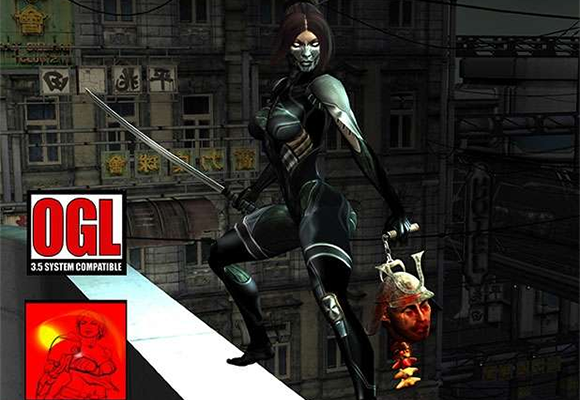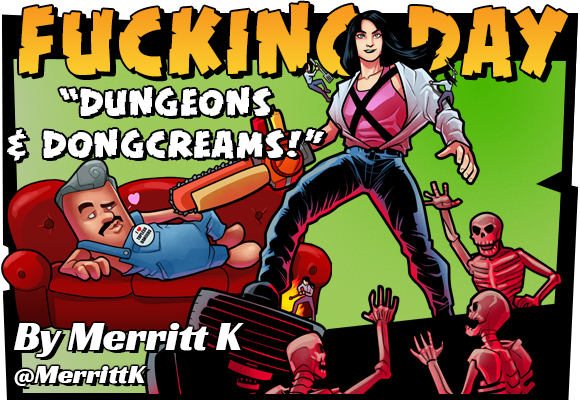
In the world of sexual tabletop roleplaying, games exist on a continuum with The Book of Erotic Fantasy on one end and FATAL on the other. Essentially, do you want to frolic with elves and pixies or do complex math to calculate whether or not your character can fit something inside of them? Black Tokyo, a roleplaying game supplement for the D20 system created in 2008 by Chris Field, sits much closer to the “roll for anal circumference” end of the spectrum, with one important distinction: this one is in the Japanese style.
Black Tokyo opens like this:
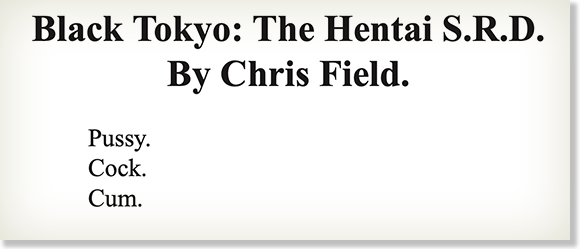
Fuck you, “Call me Ishmael!” Go to hell, “This is the saddest story I have ever heard!” “Pussy. Cock. Cum.” is officially the greatest opening of any work in the English language. These are the essential ingredients, are they not? To reduce the complex sociocultural matters of human sexuality to three nouns is no easy task, but Chris Field has studied the blade — specifically, the prehensile dick blade — for years. In this volume, he will share the fruits of his labors with us with the generosity of a patient and giving lover. But just what does a hentai roleplaying campaign entail?
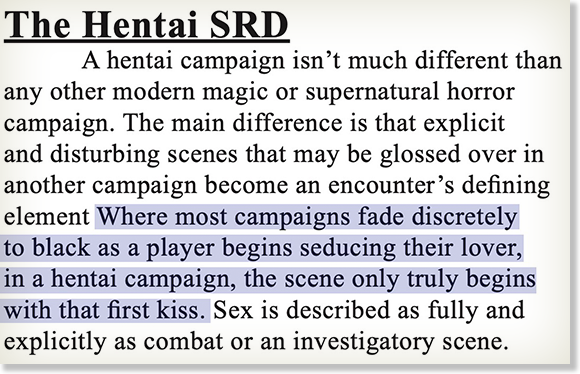
That’s right: we’re here to fuck in a non-discrete fashion. I really can’t blame him for that typo, though, because literally everyone on Craigslist Casual Encounters seemed to have trouble with it too. If you find yourself making the same error, “discreet” means you won’t tell anyone about Black Tokyo. “Discrete” refers to the kind of structure Chris Field should be imprisoned in.
Now, are there going to be any actual sexual mechanics or instructions on how to roleplay physical intimacy? Advice for how to incorporate sex into a narrative? Notes on how to set a horrific mood at the table? It’s cute that you’d think so. The entirety of Chris’s advice on actual roleplaying is “watch Wicked City. It’s that anime where a lady turns into a spider after she fucks some guy, remember that?”
Black Tokyo is what some roleplayers might derisively call a “toybook,” a tome that presents lists of new powers and equipment with little interest in developing a setting or characterization. Specifically, it’s mostly about shitting yourself to gain magic armor or turning your vag into a bladed deathtrap. But we’ll get to that.
First, for those unfamiliar with the concept of hentai, Chris helpfully lays it out:
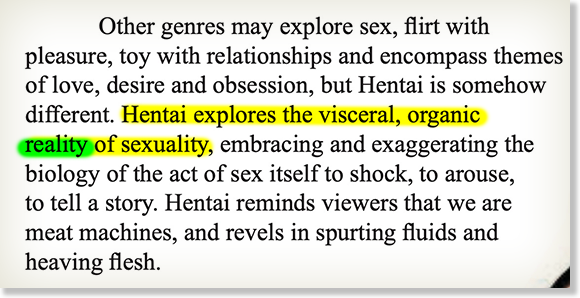
It’s fascinating to see someone try to explain the concept of pornography like this. Like ok, so you know how in most movies they don’t show the dick going in? What I’m saying is, what if there was a kind of movie where they did that? And in this case, it’s also a cartoon. I know what you’re thinking: cartoons are kids’ stuff! Not these ones, friend. Not these ones.
Speaking of the visual arts, I regret to inform you that there are a number of illustrations throughout Black Tokyo. You’re probably picturing the kind of thing you’d see in a “How to Draw Japanese Animanga” book in a Borders in 2003. But they’re worse. They look like the kind of thing a bullied middle schooler who saw Tenchi Muyo one time might draw to impress his friends in an era before omnipresent high speed internet access rendered such abilities meaningless. “Draw us a lady holding a sword and her pussy out and kind of the edges of her boobs visible,” they would cry. “You can do this,” he thinks. He can’t.
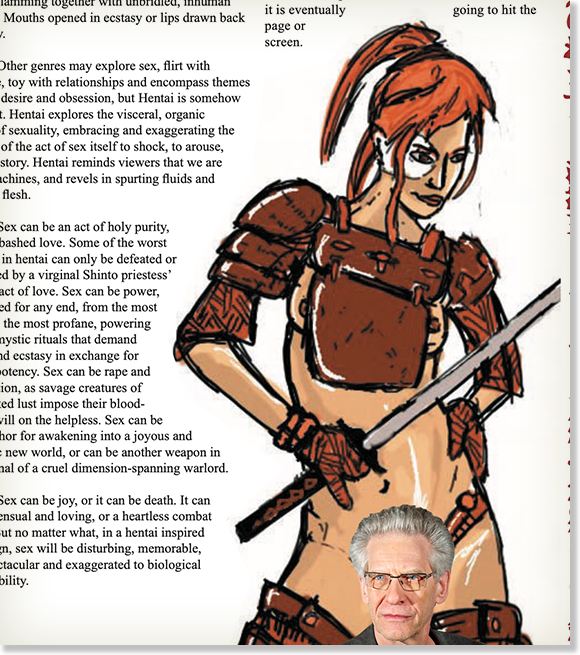
Thank you for the assist, David Cronenberg. Another curious thing about Black Tokyo is Chris Field’s constant use of epigraphs. It’s a technique you see a lot in writers who aren’t terribly confident of their own abilities, inserting quotes from famous or quirky sources to make themselves appear widely-read. Here’s the first one:
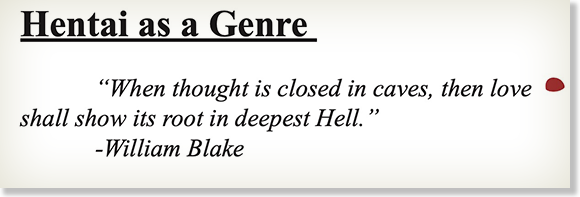
Chris Field has read or is at least aware of a quotation by William Blake! And he used it to open a section where he talks more about how when you’re drawing something, you can draw whatever you want — it doesn’t have to be something that exists in real life.
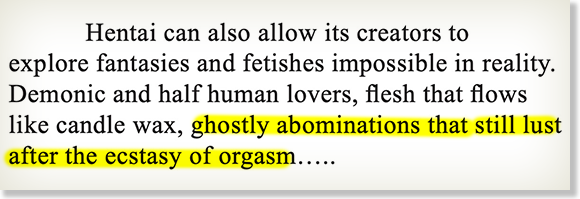
Chris’s examples of the infinite possibilities of the human imagination are: 1. What if there was a sexy devil, 2. What if someone melted but like, erotically, and 3. What if you didn’t roll over and fall asleep right after you nutted. This is a dire omen for what is to come.
You might be wondering, though, what if someone drew something that shouldn’t exist in reality? Don’t worry — Chris is way ahead of you.
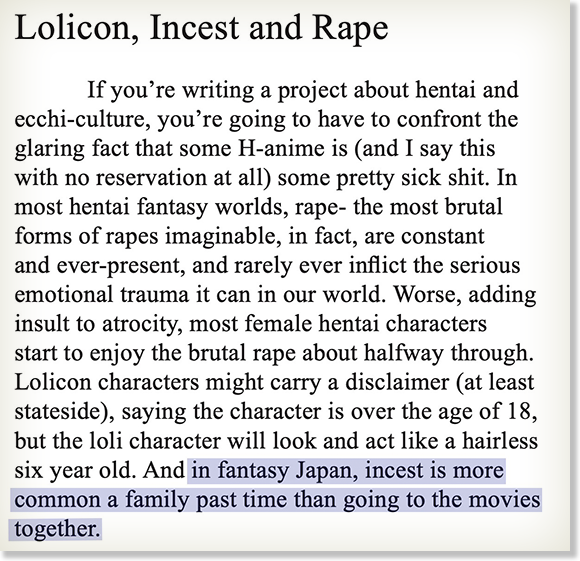
Wisely, Chris chooses to avoid the premise of sexual toddlers in his grotesque flesh carnival of the mind. But the issue of sexual violence is unavoidable in the source material, and Black Tokyo is supposed to be a supernatural horror setting, so it’s going to come up. How do you deal with that in a roleplaying environment with actual humans at the table? Modern RPGs have developed all kinds of ways to handle sensitive or potentially upsetting topics, but Chris has his own methods.
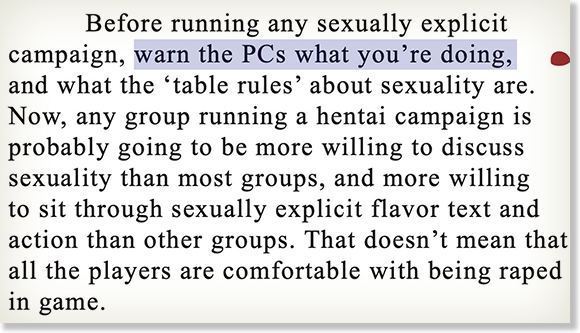
First, and this is important, you have to tell the players that by sitting down at the kitchen table with you, they are entering your magical realm of depravity. Springing a world of sexual terrors on your player group is not recommended. If they sat down for some third edition D&D and you don’t tell them that it actually stands for Defilers and Dickholes, there’s going to be trouble. Also, I know what he means, but I really wish he’d said “player characters” instead of “players” at the end there.
But how’s a game master supposed to keep track of which of their players is and is not comfortable with having their characters sexually violated? Fear not: there is a simple solution.
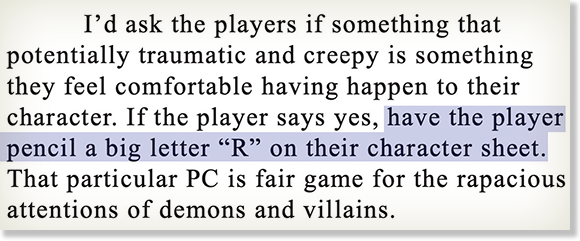
Yes, simply have your players draw a big letter R on their character sheets! You know, for— well, you know.
Now that we’ve got that out of the way, what kinds of roles might the players be taking on? Before we get to the unique races and abilities Chris Field has cooked up for Black Tokyo, he first suggests that the reader might purchase some of his other works and offers ideas on how the characters he details in those supplements might be used in this setting. Say what you will about him, the man has hustle. (And another epigraph, this time from since-outed sex pest Warren Ellis.) Unfortunately, we’re already getting into some wildly terrible ideas here:
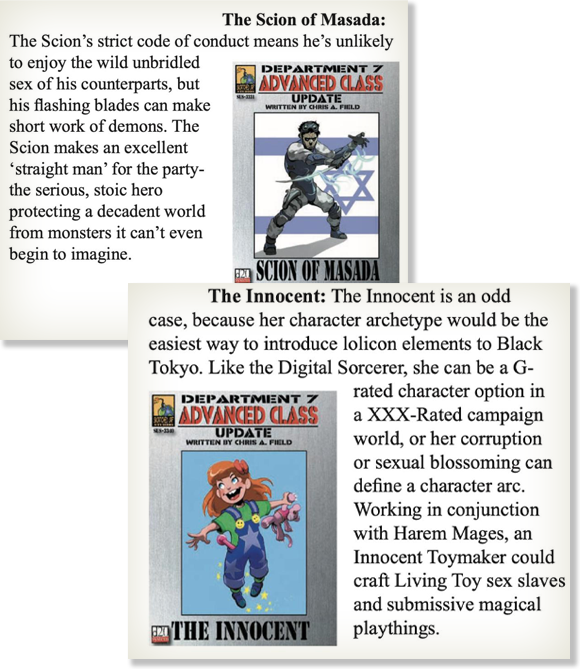
“I know I said I wasn’t including children in my catalog of sexual horrors,” Chris says, “but if you wanted to include them anyway…”
Sorry, but in the event that I am kidnapped and forced to run a game of Black Tokyo at gunpoint, I will allow neither the child who crafts “submissive magical playthings” nor the Israeli blademaster as player characters in my campaign. I’ll take the bullet, thanks.
But Chris Field, it must be said, is a rarified kind of roleplaying pervert. He isn’t content to just lay out the stat bonuses you get for fucking your grandmother without intellectualizing a little. You get the sense that he’s kind of defensive about… all this.
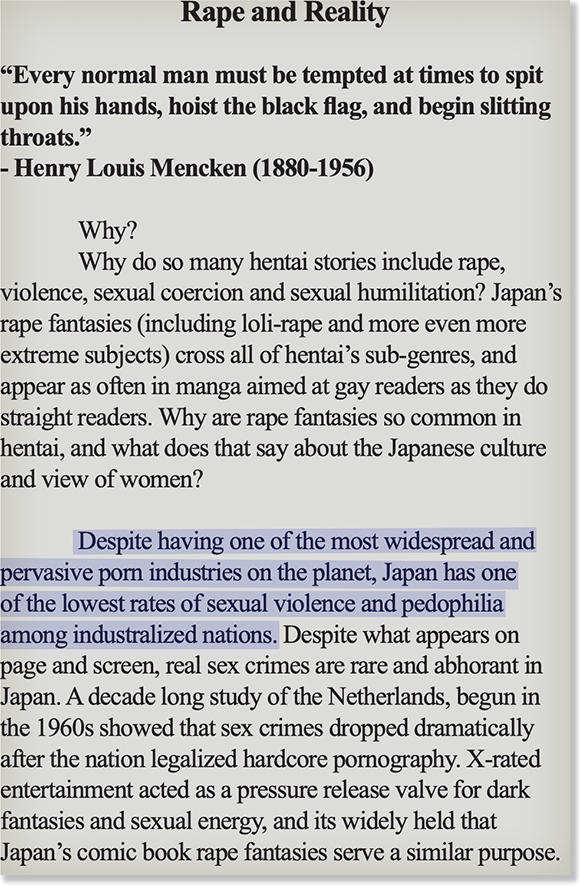
Putting aside the serious, real-world issues of rates of reporting, arrests, and convictions that obscure the day-to-day reality of violent assault, Chris describes Japan with all of the confidence of an anime-obsessed foreigner who visited once and feels that as a result, he truly understands the mysterious character of the nation. Basically, Black Tokyo is The Chrysanthemum and the Sword, except the sword is a penis.
But let’s get into the real meat and potatoes of Black Tokyo: the crunch. The section on “Hentai Feats” opens with a quote from Saul Williams, so we’re off to a great start. First up, we’ve got Barbaric Rage:
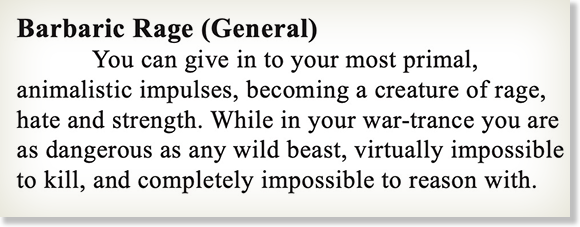
What’s hentai about this, you might ask? Well, the first thing to note is that not all of the abilities in Black Tokyo have anything to do with sex. But in this case, there’s more:
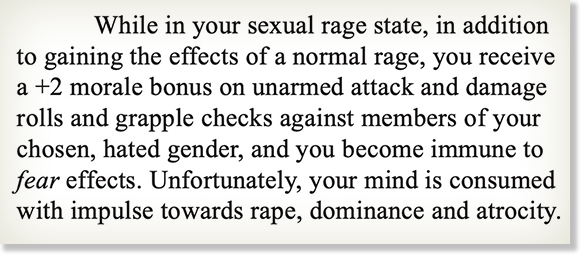
Chris Field wrote, “While in your sexual rage state,” then had to continue that sentence, noting the bonuses a character receives while seething with incel fury. The more I think about it, actually, the more this is a little too real. Can we get a picture of the world’s least erotic blowjob to lighten the mood? We can.
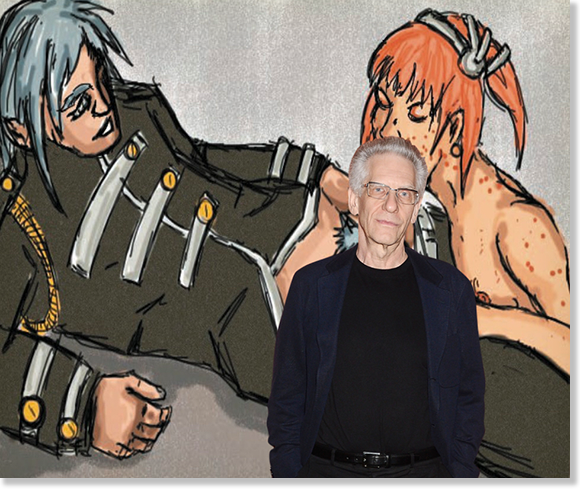
Thank you again, Mr. Cronenberg, master of the grotesque. Next up, we’ve got “Black Fatherhood.” It’s not what you’re imagining, don’t worry. Race is one of the few ways Black Tokyo doesn’t get weird. It’s actually about using your unborn demon babies to manipulate their mothers. Chris puts a Camille Paglia quote in here, and I have to think that even she would feel a little weird about that.
Now, I know I just said Black Tokyo leaves racial dynamics out of the proceedings, but there’s one exception. The feat called “Bodywalk,” which Chris describes as “one of the most fearsome hentai no judo abilities” lets you teleport between people’s bodies. There’s a catch, though:
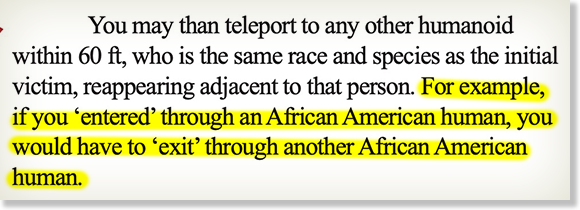
Is hentai no judo a racist form of invented sexual martial arts? Scholars have debated this question for centuries, but alas, we must move on. We must now speak on the ancient and erotic power of shitting yourself. We’re definitely going to need you for this, David Cronenberg.
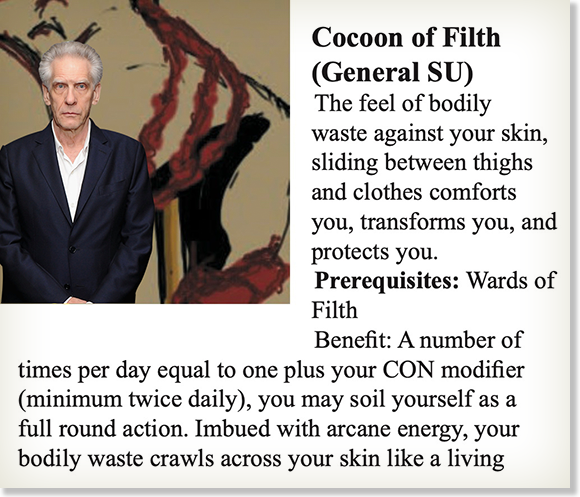
Maybe I’ve just never sought this kind of thing out, but making poop armor doesn’t seem like the kind of thing that happens in hentai. Critically, soiling yourself is a full round action, which you might think means you can’t do anything else while you’re doing it. However, a quick look at the D20 system rules indicates that while taking a full round action, you can also take a five-foot step in any direction as well as perform free actions, which include dropping prone and speaking. So you could, in theory, announce your intentions, take a single step, fall over, and piss and shit all over yourself to activate your pee pee doo doo armor.
A bunch of the feats have to do with incest, which seems to be a preoccupation for Chris. There’s one where you can do a Freaky Friday with a family member (if you have sex with them first), there’s another that gives you and a family member a stat boost (if you have sex with them first), and finally, a feat that lets you “forge a mystic bond” with your immediate family (if you watch them crank off first). Hm. I’m going to need some art of one of Santa’s elves fondling a diseased Smurf to continue.
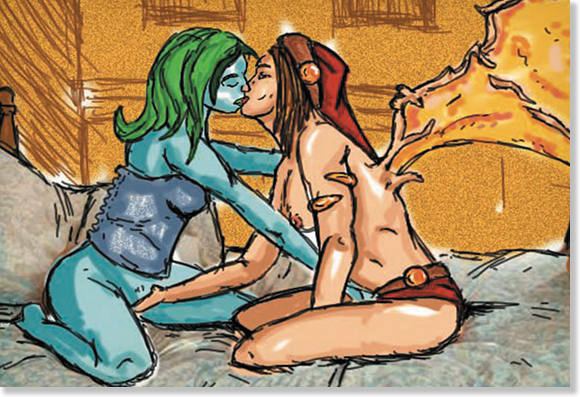
Thanks, Chris. And to Mr. Cronenberg for giving us a full, unobstructed view.
Let’s get back to hentai no judo. I promised you prehensile dick blades, and prehensile dick blades I intend to deliver.
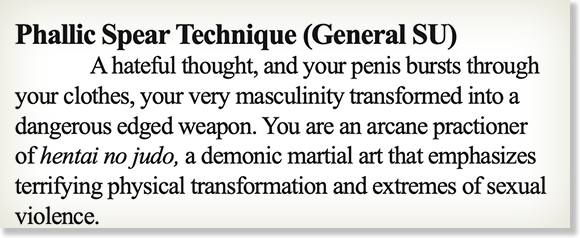
Certainly the power of the Phallic Spear Technique is formidable. But practitioners must be cautious. Maybe you can see where this is going.
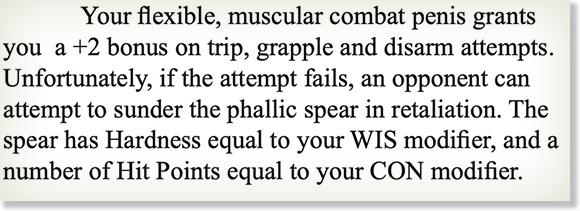
Yes, your weaponized cock remains vulnerable to amputation. In the D20 system, Wisdom (WIS) determines your “common sense, perception, and intuition,” which is a weird stat to tie to how hard your hog gets. Arguably, those high in common sense would see the immediate issue with swinging their unit around in battle. It is written: those who live by the dick blade shall die by the dick blade.
Phallic Spear Technique not enough for you? Take the “Misogynist Blade” feat!
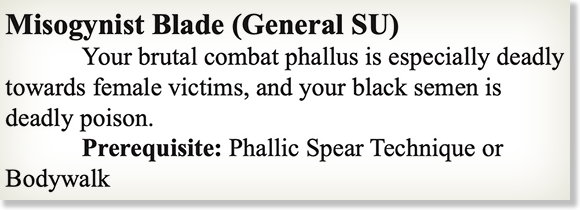
So now it’s not enough that guys need to have big dicks. They have to have a “brutal combat phallus.” Much like Chris Field’s flexible battle shaft, male sexual standards are getting out of hand.
Things have been pretty phallocentric so far — what does the world of Black Tokyo have to offer female characters? I’m glad you asked!
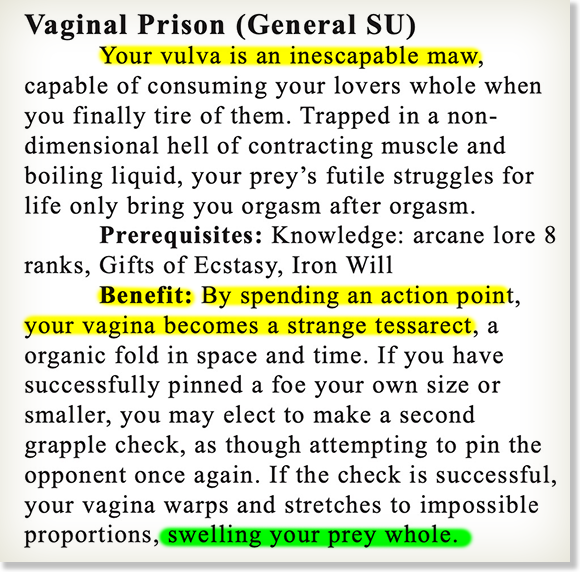
Vaginal tesseracts! Now we’re talking. No more awkward conversations after you do the deed — just become a sexual Kirby and hoover up your discarded lovers into a non-dimensional hell. And that’s not the only yonic magic Black Tokyo has in store.
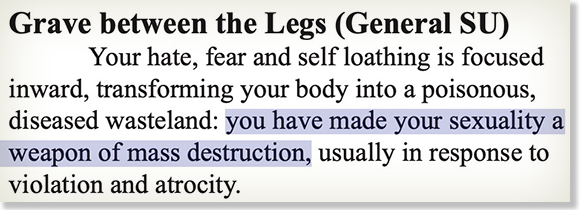
You gotta hand it to Chris Field sometimes. “You have made your sexuality a weapon of mass destruction” is an extremely powerful phrase.
Other feats include giving birth to demons, petrifying your lovers with sexual fluids, and reverting the fools imprisoned in your internal pocket dimension into fetuses. But it’s not all pussy stuff. There’s one called “Womanly Suffocation” where your tits melt and choke the life out of a rival hentai no judo practitioner.
And then there’s “Painted With Seed,” an ability that lets you gain stat bonuses from being nutted on. Sure, fine, right? That’s probably the least bizarre thing we’ve seen so far. That’s what you might think, until you realize that Chris thought up specific bonuses for each body part someone’s man milk lands on. Again, maybe you’re thinking I just mean face, tits, or ass. No, I mean 11 discrete body parts.
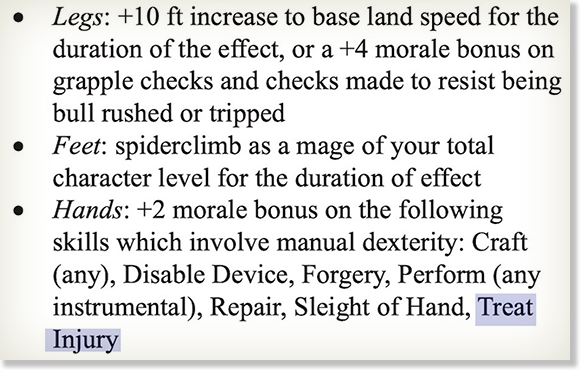
Look, I know you want to do it inside, but could you finish on my hands? I’ve got to do open heart surgery later.
Moving on to character classes, Black Tokyo gives you seven to choose from.
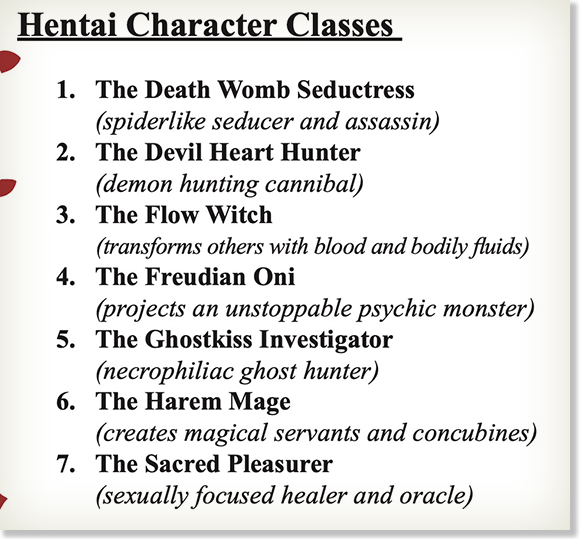
All the greats are here: demon hunting cannibal, necrophiliac ghost hunter, unstoppable psychic monster. I fully expect that all of these have already been modded into Baldur’s Gate 3.
The “Death Womb Seductress” can crawl around like a spider and turn her vulva into blades, which Chris explains can be used as a natural weapon in combat.

Look — you can attack with your vagina dentata while standing up. But that doesn’t mean you should.
Here Chris also commits the error common to so many men making jerkoff material: not knowing what a uterus actually is. Is it the hole? Can a dick go in there? Hentai scientists aren’t yet certain, nor is Chris.
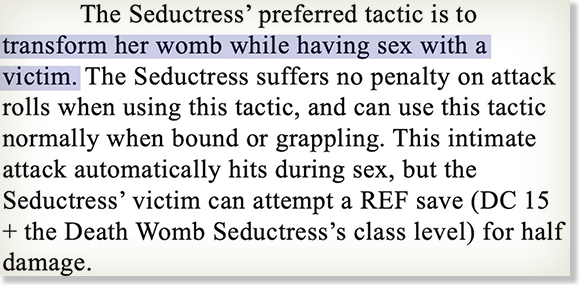
As for the other classes, the Freudian Oni wields a violent sex offender tulpa, the Flow Witch does magic by squirting, the Harem Mage creates sentient slave women, the Devil Heart Hunter is just kind of boring, the Sacred Pleasurer does mystic yoni spells, and the Ghostkiss Investigator is Dan Aykroyd in that one part of Ghostbusters. Also, Chris uses a Jenny Holzer quote to introduce it.
What’s left? Equipment, miscellaneous non-horny spells, things of that nature. There’s a piece of gear that’s just The Guyver but what if it was one of those sex eggs you have to bust into to activate it.
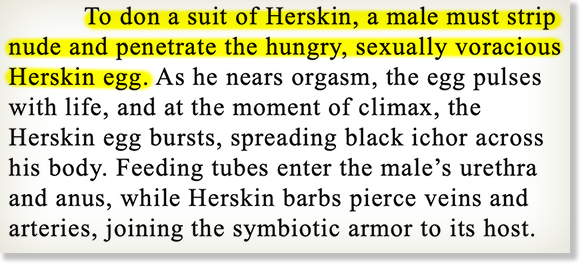
Lastly, we’ve got a bunch of monsters and worldbuilding notes, such as they are. Some of these are based on actual Japanese myths, but don’t let the names fool you into thinking these are authentic reproductions — Chris has added some of his own secret sauce.
Take the “Akaname,” a yokai that supposedly licks the grime and scum from bathroom floors if they aren’t regularly cleaned. In Black Tokyo, he is essentially a kind of poop vampire.

There’s also a slime monster, like in a conventional fantasy roleplaying game, but it’s made of cum.
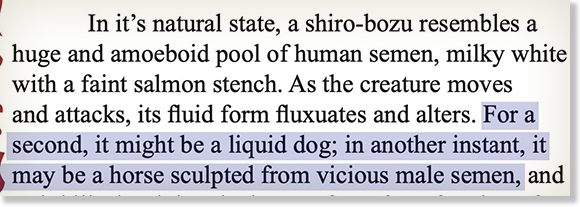
“Vicious male semen.” There’s another one of those magical phrases never before uttered until Chris Field sat down to bang out Black Tokyo.
Speaking of, you might be aware that different kinds of dragons have different kinds of breath weapons in D&D. Red dragons spew conventional fire, white dragons breathe icy winds, and Black Tokyo’s “storm dragon” exhales — come on, you know by now.

Cum. It’s cum.
Somehow, we’ve made it this far without mentioning catgirls. Chris has been so intent on weaponizing incest and feces that he’s lost sight of the classics, the erotic tropes that have endured for decades. What if a woman was also kind of a cat, widely considered to be the sexiest of all domestic animals?
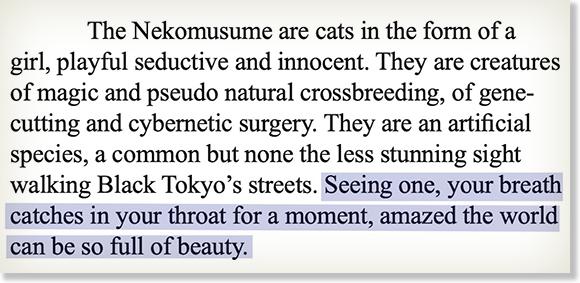
Gaze upon the beauty of the Nekomusume and thank whatever god you pray to that existence can contain such wonders. Cronenberg, you’re on hole blocking duty one last time.
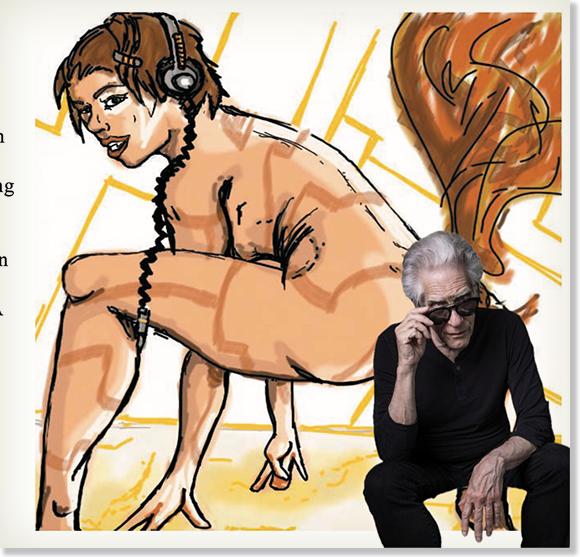
Ok, I cheated. That’s actually the mystical kitsune trickster. Still, pretty erotic, right?
We’ve seen a lot of strange stuff in Black Tokyo. We’ve witnessed a man fascinated by Japanese animated pornography attempt to create detailed rules for devouring someone whole with your cunt. We watched as he awkwardly tried to explain that actually, all of this is good for society, if you think about it. And we’ve seen him quote William Blake, Veruca Salt, Mark Millar, NOFX, and more. But surely he wouldn’t go so far as to quote himself in his own book like some kind of early 2000s message board user, would he?
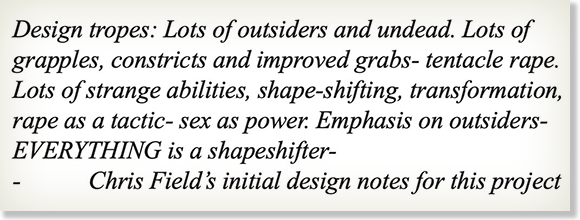
Of fucking course he would.
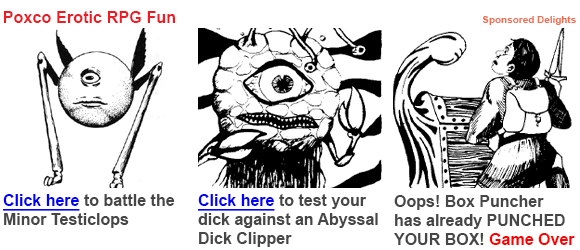
This article was brought to you by our fine sponsor and Hot Dog Supreme: KNM, who is a titty vampire. Just a good old fashioned titty vampire, like we used to have before all you kids got weird with this stuff.

